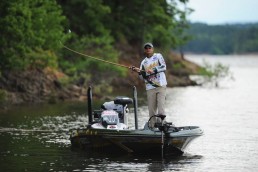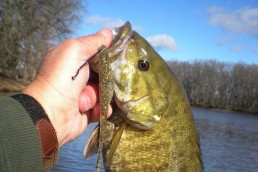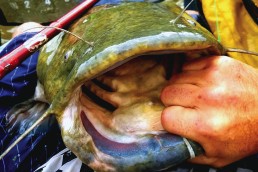SHARE THIS POST
Homer Circle was the angling editor for Sports Afield magazine for years and was held in high esteem for the advice he gave to practical anglers. In The Art of Plug Fishing, published in 1973, “Uncle Homer,” as he was known to his legion of followers, devoted an entire chapter called, “Your Short Casts Are Long Enough.” In the section Circle contended that casts of 35 to 40 feet should do the job.
In recent years, though, techniques like flipping and pitching have focused attention on shorter casts. From 15 to 20 feet, a jig, spinnerbait or Texas rig may be dropped more accurately and quietly, and more systematically than from farther away.
But sometimes the longer casts are needed.
Years ago, when fishing the Susquehanna River near Harrisburg, Pa., I could see smallmouths slinking into deeper water as I waded toward them. It was autumn, and the water was low and clear. The only way I could catch these skittish fish was with long casts—well beyond where I thought fish might be and then manipulate my lure into likely holding spots. With the longer casts, at 75 feet or so, I could reach fish without spooking them.
Often, between a spot where an angler can wade and where fish are holding, the water is too deep to wade.
Several years ago I was wading in the Madison River, downstream from Ennis, Mont. The water was close to the top of my waders and I was not certain what the next step might bring. As I read the water it seemed to me the best area was nearly 100 feet away. I could cast that far, but not easily. I took off the air-resistant strike indicator and casted. In the second or third drift, something big grabbed my nymph and headed for Bozeman. The fish turned and headed back upstream. But before I could recover it was gone. Experience confirmed, however, the utility of a long cast.
While most streams of the Upper Midwest are not as broad as the Madison or Yellowstone, there have been plenty of spots on the Manistee or Grand rivers in Michigan where the water was at the top of my waders and I wanted to fish “over there.”
When fish are scattered over a wide area, longer casts may be the most effective means to establish a pattern. As a young man targeting pike in northern Michigan, I learned how long casts could identify where fish were holding. After beating the edges of a large weed bed to no avail, I began to cast my River Runt (Remember that one?) far into the weeds. I varied the speed of the lure to make it dive into pockets in the weeds and float around or over the heavy weeds. I caught pike where I had never cast a lure before.
Are you enjoying this post?
You can be among the first to get the latest info on where to go, what to use and how to use it!
Pike and muskies often follow a lure a long way before striking. Research at Chippewa Falls has showed that muskies are alerted by the sound of a trolling motor. While the muskies did not flee, divers noticed the fish turned toward the sound and appeared nervous. A long cast can put a lure near these fish before the boat noise or shadow alarms them.
Gordy Johnson and I were once muskie fishing on Pipestone Lake and in a part neither of us knew well. As the wind shoved us along the bank, we noticed a reef in deeper water. Gordy heaved his Bull Dawg toward the rocky outcrop and let it sink, swinging along the slope. It got deeper and deeper. Gordy then grunted and set the hook. Had we gotten closer, the fish would’ve been under the boat and likely not have taken the lure.
In midsummer and midwinter, many gamefish move deep. Mid-lake drop-offs and the ledges and humps are great places to find them. While these can be reached by jigging vertically, long casts help to reach the required depths. In addition, longer casts permit a jig, Texas rig, or other fall bait to cover multiple depths as it sinks along the sloping substrate.
Tony Garitta and I fished Jackfish Lake once and caught monster smallmouths with tube grubs casted 60 or 70 feet toward the shore and worked systematically down a sloping bank. About the steepest a crankbait can dive is 45 degrees—it’s physics. For the lure to dive, line has to be retrieved. For each foot retrieved, a deep-diving lure can go down roughly a foot—45 degrees—until the lure reaches its maximum depth. So, to get a crankbait to a drop-off, ledge or hump 20 feet deep, each cast must be at least 20 feet beyond the target.
For example, several years ago I fished with a tournament bass angler. He knew right where the largemouths were on a deep hump. He positioned the boat over the hump, and we could see fish on the depth finder.
“Cast as far that way as you can, and when I start moving the boat let line out until I tell you to crank,” the angler told me.
When I got the word, I had 150 feet of line out. But when the lures got to the hump, they were deep. We caught 15 largemouths on 16 casts.
Over the years of my writing career, one highlight was meeting and becoming friends with Homer Circle. My copy of The Art of Plug Fishing carries the message: “Tim, my friend … hope you live almost forever. … God bless, Uncle Homer.”
MWO
SHARE THIS POST
Did you enjoy this post?
You can be among the first to get the latest info on where to go, what to use and how to use it!
Tim Mead
Tim Mead is an established outdoor writer and photographer with more than 500 credits in state, regional and national magazines. He is an “Excellence in Craft” award winner from both the Outdoor Writers Association of America (of which he is also vice president) and the Southeast Outdoor Press Association (as well as being past president).



